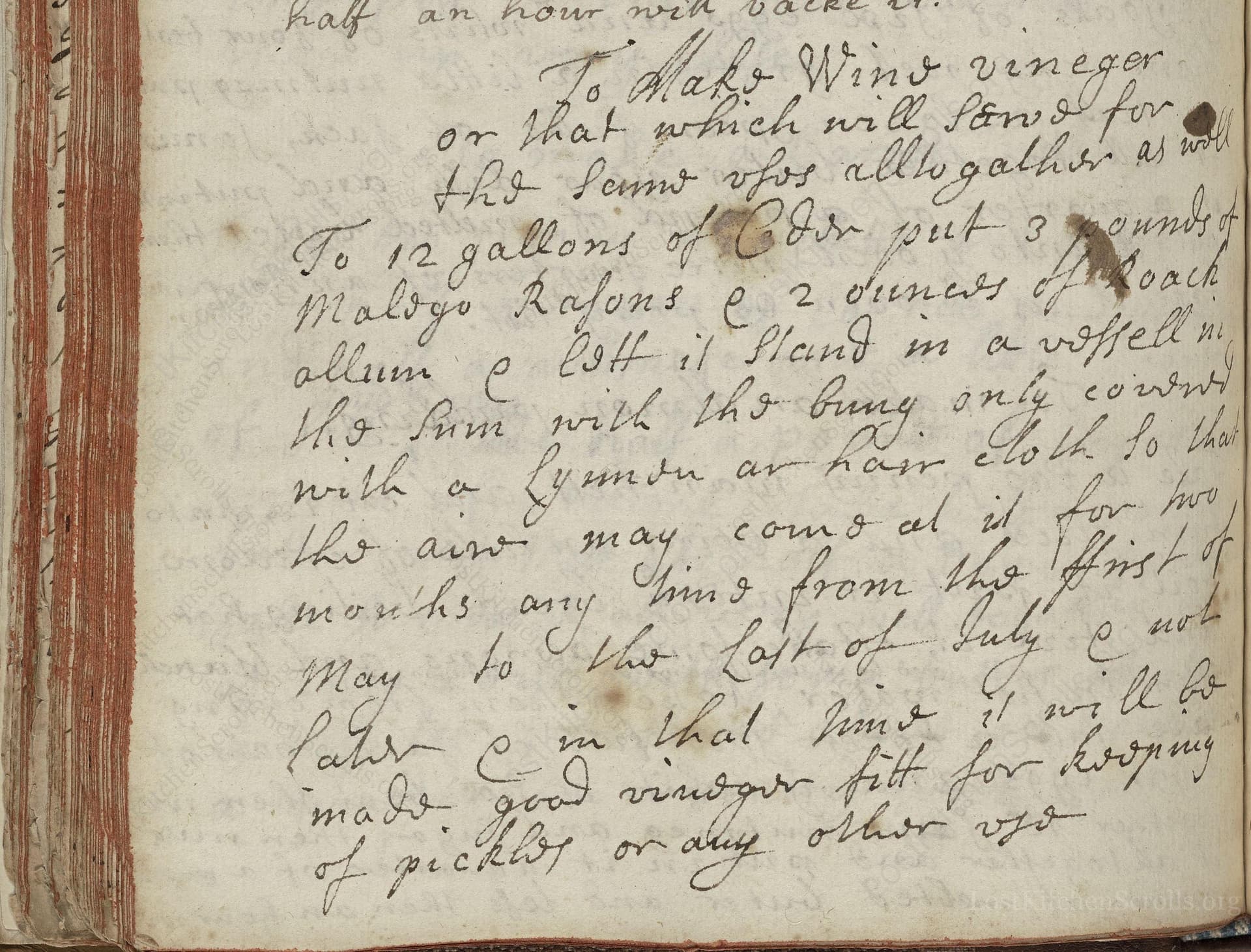To Mako Wind Vineger
From the treasured pages of Cookbook of Constance Hall
Written by Constance Hall

To Mako Wind Vineger
"or that which will serve for Some vses altogether as well To 12 gallons of Cydr put 3 pounds of Maligo Raisons and 2 ounces of Roach allum and lett it stand in a vessell narrow with the bung only covered with a Lynnin or hair cloth so that the aire may come at it for two months any time from the first of May to the Last of July and not Later in that time it will be made good vineger fitt for keeping of pickels or any other vse."
Note on the Original Text
The original recipe uses phonetic and period-typical spellings, such as 'Mako' for 'make,' 'wind' for 'wine,' and 'vineger' for 'vinegar.' Directions are brief and assume prior experience; quantities use the then-standard imperial measures. The timing emphasizes the importance of warm weather for the fermentation process. The recipe does not clarify the role of 'Roach allum' (alum), reflecting the time's looser understanding of food science. Instructions were straightforward and oriented toward practical housewifery rather than precise laboratory-style procedure.

Title
Cookbook of Constance Hall (1672)
You can also click the book image above to peruse the original tome
Writer
Constance Hall
Era
1672
Publisher
Unknown
Background
A spirited foray into 17th-century kitchens, this collection by Constance Hall brims with the flavors, secrets, and delicacies of Restoration-era England—perfect for cooks keen to revive a dash of history in their modern menus.
Kindly made available by
Folger Shakespeare Library
This vinegar recipe comes from Constance Hall, who was active in the late 17th century, specifically 1672. At this time, household vinegar-making was a vital skill, especially for preserving food through pickling before refrigeration. The use of cider and raisins combined the natural sugars and yeasts needed for fermentation. Alum was frequently employed as a clarifying agent and as a preservative. This recipe is a fine example of early English culinary ingenuity in an era before commercial vinegars were widely available.

Historically, this vinegar would have been made in a wooden or earthenware vessel with a narrow opening to minimize contamination but still allow airflow. The vessel was covered with a cloth—typically linen or sometimes horsehair—to keep out insects and debris while permitting necessary exposure to air. Cooks would have used wooden paddles or spoons for mixing, and simple weights to submerge solids if needed. No modern fermentation locks were used; the environment relied on ambient conditions.
Prep Time
15 mins
Cook Time
0 mins
Servings
3000
We've done our best to adapt this historical recipe for modern kitchens, but some details may still need refinement. We warmly welcome feedback from fellow cooks and culinary historians — your insights support the entire community!
Ingredients
- 12 gallons dry cider
- 3 lbs Malvasia (Maligo) raisins or substitute with regular dark raisins
- 2 ounces food-grade alum (potassium aluminum sulfate)
Instructions
- To make a historical style wine vinegar inspired by Constance Hall's 1672 recipe, start with 12 gallons of dry cider.
- Add 3 pounds of Malvasia (Maligo) raisins, or substitute with regular dark raisins if unavailable.
- Dissolve 2 ounces of food-grade alum (potassium aluminum sulfate) in the cider.
- Pour the mixture into a large, narrow-mouthed vessel, leaving the top covered with a linen or muslin cloth so air can reach the liquid.
- Allow it to stand at room temperature for two months, preferably between May and July.
- After two months, strain and bottle the vinegar for use in pickling or as a general purpose vinegar.
Estimated Calories
10 per serving
Cooking Estimates
You’ll need about 15 minutes to get everything ready and mix your ingredients. There is no actual cooking involved, just waiting for the vinegar to ferment, which takes two months. Each serving is estimated at 15 ml (about 1 tablespoon), and each serving has roughly 10 calories since most of the original cider sugar is gone after fermentation.
As noted above, we have made our best effort to translate and adapt this historical recipe for modern kitchens, taking into account ingredients nowadays, cooking techniques, measurements, and so on. However, historical recipes often contain assumptions that require interpretation.
We'd love for anyone to help improve these adaptations. Community contributions are highly welcome. If you have suggestions, corrections, or cooking tips based on your experience with this recipe, please share them below.
Join the Discussion
Rate This Recipe
Dietary Preference
Culinary Technique

Den Bockfisch In Einer Fleisch Suppen Zu Kochen
This recipe hails from a German manuscript cookbook compiled in 1696, a time whe...

Die Grieß Nudlen Zumachen
This recipe comes from a rather mysterious manuscript cookbook, penned anonymous...

Ein Boudain
This recipe comes from an anonymous German-language manuscript cookbook from 169...

Ein Gesaltzen Citroni
This recipe, dating from 1696, comes from an extensive anonymous German cookbook...
Browse our complete collection of time-honored recipes



